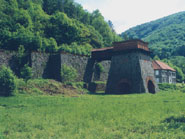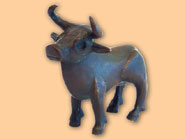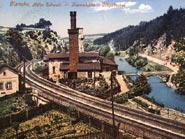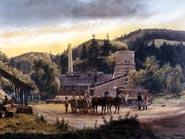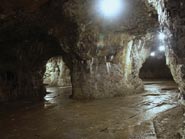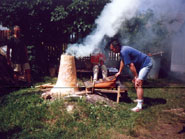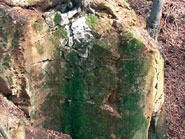THE BLANSKO REGION - THE MORAVIAN KARST - THE MORAVIAN KARST IRON TRAIL
Welcome to the Blansko region ...
... to a region blessed with wonderful countryside and dense forests, to an
area enveloped in the past in the smoke from ironworks and kilns, where people
with their faces scorched by the blacksmith’s furnaces lived... to places where
unique artistic castings were produced, and are still produced to this day ...
The Moravian Karst Iron Trail project
The Moravian Karst Iron Trail project is part of the international European Iron Trail programme. The aim of the project is to promote important localities representing the various directions taken by the European iron industry in the past. The Moravian stop of the trail lies on the eastern route of the European Iron Trail, which leads from Trondheim in Norway, through Sweden, Denmark, Poland and Moravia, to Burgenland in Austria.The five routes of this educational trail will lead you through the most important iron industry localities in our region. The signposted section leads through specially protected areas, including the Moravian Karst nature reserve.
The Blansko route
Blansko - a town with a rich history, closely associated with iron and the production of artistic castings.
Large-scale iron production in Blansko was begun in 1698 by the Gellhorn family, although its greatest boom came in the first half of the 19th century.
The most important monument in Blansko is the chateau - home to Blansko Museum, whose permanent exhibitions focus on the artistic castings for which Blansko is famous, the history of iron production and smelting, the Moravian Karst, and the history of Blansko and the surrounding region. It also offers visitors tours of the chateau’s historical interiors. Other monuments in the area include a wooden church from Sub-Carpathian Ukraine and Saint Martin’s Church.
Klamovka - all that has remained of this originally industrial site is a single-storey building without a blast furnace, a charging tower and part of the old boiler house and engine room with a chimney. The Klamovka site is a typical example of the industrial architecture of the middle of the 19th century.
Paulinka - this site lies at the spot where the Punkva River flows into the River Svitava. It was used as a foundry from the end of the 19th century, and as an engine room from the beginning of the 20th century.
The Olomučany route
Olomučany - iron ore and refractory clay for foundry moulds was extracted in the immediate vicinity of the village from the early Middle Ages until the end of the 19th century. There was a glassworks in the village from the 17th century, and a ceramics goods factory from the 19th century. You can see some Olomučany ceramics in a small exhibition in the Local Authority building in Olomučany, displaying a wide range of two types of ceramics - the white “folk” ceramics with their typical colourful floral motifs, and the “town” ceramics - richly decorated kitchenware with coloured glazes.
Padouch - limestone was extracted and lime burned here, evidence of which is provided by the surviving remains of a rustic limekiln from the 19th and early 20th century.
Milířiště - charcoal was made here in charcoal heaps.
The U Kukačky (The Cuckoo) and U Srnce (The Deer) ironworks - the remains of a total of six ironworks can be found by the wells of the same names.
The Vystrčená Scrapes - a group of surface depressions (places where a small amount of iron ore was extracted by surface mining).
The abandoned village Polom - located in the middle of the ore deposit area; ceramics dated to the turn of the 12th and 13th centuries have been found here.
The Rudice - Jedovnice route
Jedovnice - formerly an important centre for traders and craftsmen; fisheries and the sale of products made by ironworkers from Rudice and weavers and potters from Jedovnice flourished here. In 1335 it was elevated to town status. The dominant landmark is the Church of Saint Peter and Paul, while the local countryside is famous for fishpond cultivation - the largest fishpond is named Olšovec.
The Hugo Ironworks - established in 1746 on the site of the present sawmill and closed at the end of the 19th century. The stone retaining wall with a tunnel opening, through which water was drawn from the Floriánek fishpond, survives to this day.
Rudice - the history of Rudice is linked in particular to iron ore mining. The extraction of ore ended along with the end of the operations of the ironworks in Blansko in 1896, though the extraction of clay and sand continues to this day. The symbol of Rudice is the Windmill, which houses an exhibition on the history of the village, and the history of smelting, mining and mineralogy. The site also features a geological park with specimens of karst rocks.
Žegrov - a karst depression filled with layers of Rudice rock. Iron ore was also mined here.
Černé Hlíny (Black Clays) - refractory clay was extracted here; after extraction ended one of the largest of the Rudice lakes was created here.
The U Kapličky (Chapel) Lake - the lake was formed here after the extraction of sand and clay ended. Jurassic fossils have been found here.
The Křtiny - Habrůvka route
Křtiny - one of the most important places of pilgrimage in Moravia. The most prominent landmark in the village is the baroque Church of the Name of the Virgin Mary - the work of the architect Jan Blažej Santini Eichl. The church is his largest work, and was built on a ground plan in the shape of a Greek cross.
The cave Výpustek lies not far from Křtiny. Phosphate clays were extracted in the cave at the beginning of the 20th century. At the end of the Second World War it was turned into an underground factory. At the end of the 20th century a military bunker was built here.
Habrůvka - the history of the village is closely associated with the extraction and processing of mineral raw materials. Charcoal for the ironworks was burnt in the surrounding forests, although the village is particularly noted for lime burning in rustic limekilns. Habrůvka was also famous for the production of wooden furniture.
Elise - the deepest of the iron ore mines.
Panské Boudy - the steep-sloped pit was formed by the working of a seam of Rudice sand and clay.
The Adamov - Josefov - Babice nad Svitavou route
Adamov - originally a settlement from the 16th century. Records from 1632 indicate that there was a blast furnace here. Iron-mills were built here in the years that followed, and in 1680 another two blast furnaces and a pair of forges built. Increased demand for cast iron led to the establishment of a new blast furnace (at the Františka Ironworks). The dominant landmark in Adamov today is the neo-Gothic brick parish church - Saint Barbara’s, which holds a unique late Gothic work in the form of the Zwettl Altar.
Nad Bílou Skálou - the interesting site of an abandoned iron ore mine.
The Františka Ironworks - a blast furnace dating back to 1746, mainly producing cast goods, particularly for military purposes. Its operations ended in 1877. This is now one of the oldest surviving furnace in central Europe.
Althamr - evidence of the existence of the first iron-mill on the Novohrad estate is provided by documents from 1506.
Býčí Skála - the cave is famous for the discovery of the “Burial of the Magnate of Halštat”, made here by Jindřich Wankel. A forge with bronze artefacts, including the famous statue of a bronze bull, was also discovered here during the excavations.
Babice nad Svitavou - the village was evidently established in the 13th century along with a stronghold. Archaeological evidence of a Slavonic ironworks has been found on the southern edge of the village.
Malá Macocha - an abandoned iron ore mine. The pit was dug in several narrow gorges to a depth of around 42 metres. After extraction ended the karst pocket was filled in with waste rock.

